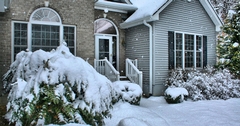If this is an emergency, call (980) 737-9118 for immediate assistance.
American Restoration Disaster Specialist
10 Tips for Winterizing Your Home This Year

It's usually around September and October, when the leaves begin to change, that we start to think, "Wow, this year has really flown by!" Before you know it, there's a chill in the air. You may be ready for those cooler days, but is your home?
American Restoration helps you prepare with these 10 tips:
1. Clear your yard.
Check in with the trees around your property. Do any of them need to be trimmed or removed? Wind, snow, and ice can cause unhealthy tree branches to fall, which can damage your house, car, or even yourself. While you're out there, pick up any debris in your yard, including sticks and rocks. A layer of snow can hide tripping hazards, which can lead to injury.
2. House the hose.
Make sure your garden hoses are removed from the exterior faucets and store them inside for the winter. Make sure valves are closed, and insulate the faucet to prevent freezing and cracking as temperatures fall.
3. De-gunk the gutters.
Clogged gutters can cause a buildup of water, ice, and snow. As water pools and sits, it can seep into your home, creating rot, mold, and mildew. Though these issues may not be immediately visible, they can make your family and guests sick, and should be remediated. Prevent it from happening by cleaning out the gutters, and installing gutter guards if possible.
4. Stop the slips.
Keep your family and any visitors safe while entering and exiting by making sure any walkways are repaired and handrails are secure. If you have wooden steps, consider adding traction slips to improve grip. Stock up on ice melt before the weather turns bad to ensure that you have a supply handy.
5. Caulk the cracks.
Prevent cold air from seeping into your home by caulking around gaps and openings. Install weather stripping around windows and doors (don't forget about the garage door!).
6. Protect the pipes.
Insulate any pipes that may be susceptible to freezing. When the temperature drops below 32 degrees Fahrenheit, keep a stream of water running in a few faucets to guard against freezing and bursting.
7. Spot the shut off.
Knowing where your water shut off valve is can save a lot of trouble if you experience a burst pipe. Once you locate it the valve, we recommend tagging it or highlighting it in some way so that it's easy to find in an emergency.
8. Check the chimney.
It's important to have chimneys cleaned regularly if you have a wood-burning fireplace or stove. Buildup of creosote, a sticky and highly flammable substance that is released from burning wood, is a major hazard for homes. Now is also a good time to make sure your HVAC filters have been changed and your air ducts are cleaned. For more about duct cleaning, check out www.AmDuct.com
9. Demo the detectors.
December, January, and February are the most common months for residential fires. We urge you to make sure you test your fire detectors and replace the batteries if needed. Better yet, test monthly for best results. If you don't already have one, a carbon monoxide detector is another important piece of safety equipment. Without one, the odorless, colorless gas could be undetectable until it is too late.
10. Keep it cozy.
Make sure your home is well insulated, and keep your thermostat set to at least 68 degrees Fahrenheit. To conserve energy and reduce your electrical bill, Energy.gov recommends lowering the temperature while you are asleep or away from home. Lowing it 10-15 degrees for 8 hours can reduce your bill by 5-15%.
Winter can be a wonderful time of year, but it's made all the better by keeping your home and those you love warm and safe. If you do experience a disaster-related emergency, know that you can always count on your local and trusted Disaster Specialist. The American Restoration team responds 24 hours a day, 7 days a week - including holidays - because we know that disasters do not wait for business hours. Contact us today at (980) 737-9118
Recent Posts
-
As You Deck the Halls this Season be Fire Smart
December 01, 2022
-
Practice Safety with Space Heaters
November 01, 2022
-
Dealing With Water Damage [Infographic]
June 01, 2022